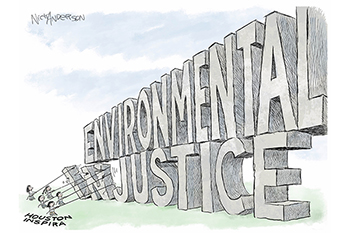Concrete Batch Plants
Bill Sponsors / Authors:
![]() Rep.
Armando Walle
Rep.
Armando Walle
D - Houston
Supporting Documents / Links:
- Restriction on concrete batch plants stall in Texas Legislature, but modest reforms advance
Houston Chronicle - April 28, 2023 - The EPA wants to limit how much soot you breathe. Here’s what it means for Texas and one of its historic Black towns.
Texas Tribune - March 21, 2023 - Best & Worst 2023
Texas Monthly - June 13, 2023
 Particulate Matter 2.5 Monitor Funding
Particulate Matter 2.5 Monitor Funding
The greatest concern for advocates is what’s known as fine particulate matter, or PM 2.5, that escapes during this whole process. The particles are smaller than sand and can be inhaled deep into the lungs and potentially enter the bloodstream, triggering heart attacks, coughing and making breathing difficult, according to the Environmental Protection Agency.
The technical name is particulate matter 2.5, or PM 2.5. These particles, which are 30 times smaller than a single strand of hair, cause air pollution. And this air pollution can lead to health complications. Some scientists call it the deadliest form of air pollution.
Older residents, pregnant people and children are most susceptible to harm from PM 2.5. The particles can trigger asthma and other lung conditions like bronchitis. Other health problems linked to particulate matter are irregular heartbeat, aggravated asthma and respiratory diseases.
Sources of PM 2.5 include black smoke coming out of a diesel truck or wildfires, unpaved roads, construction sites, and other chemical reactions like pollutants emitted from power plants, cars and factories.
State Rep. Armando Walle included a measure in the state budget that would devote an extra $2.5 million to TCEQ’s air quality budget and require the agency, which already focuses on reducing ozone pollutants, to do the same for fine particulate matter.
The Environmental Protection Agency recently proposed new limits to particulate matter that would require states, counties and tribal governments to meet a stricter air quality standard for PM 2.5.
- The federal environmental agency proposed the current annual standard for PM 2.5 of 12 micrograms per cubic meter be changed to a level between 9 and 10 micrograms per cubic meter to reflect the latest health data and scientific evidence.
Reducing air pollution has been a prime focus of the Biden administration’s environmental agenda. These new, stricter standards aim to help residents in what the federal government calls “environmental justice communities.”
In Texas, 80 air monitors measure for PM 2.5 in 33 of its 254 counties, according to the Texas Commission on Environmental Quality. The agency determines the locations of the air monitors based on population trends, reported emissions inventory data and potential local air quality concerns.
The agency is likely to base any decision on the average air quality during a three year period.
If the federal rule were in place today, data by the EPA beginning in 2019 would suggest that eight Texas counties could exceed the proposed annual standard of 9 micrograms per cubic meter, including Dallas, Harris, Tarrant and Travis counties.